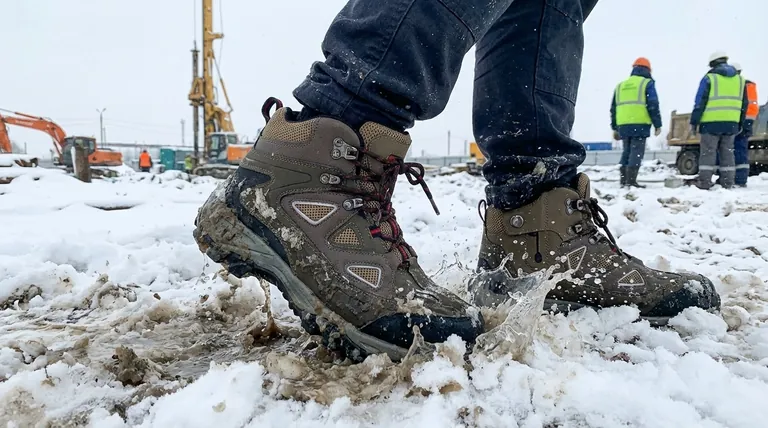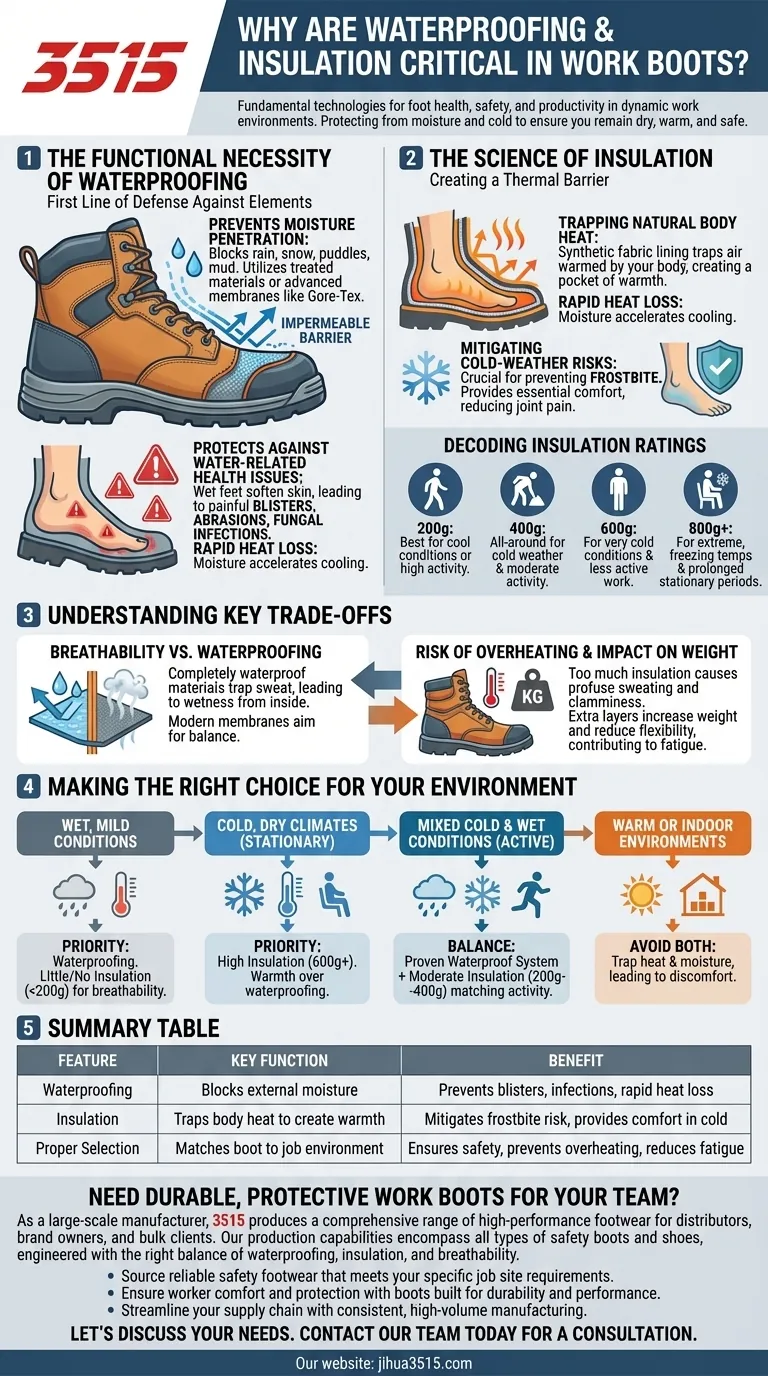At their core, waterproofing and insulation are not luxury features in work boots; they are fundamental technologies for maintaining foot health, safety, and productivity. In dynamic work environments where weather is a constant variable, these elements protect you from external moisture and cold, ensuring your feet remain dry and warm.
The real importance of waterproofing and insulation extends beyond simple comfort. These features are a critical defense system against environmental hazards, directly preventing cold-related health issues and enabling you to perform your job effectively and safely.

The Functional Necessity of Waterproofing
Waterproofing serves as the first line of defense against the elements your feet encounter on a job site. Its role is straightforward but critical.
Preventing Moisture Penetration
The primary function is to create an impermeable barrier. Materials like treated leather, rubber, or advanced membranes like Gore-Tex are engineered to block external water from rain, snow, puddles, or mud from seeping into the boot.
Protecting Against Water-Related Health Issues
When feet become wet, the skin softens and becomes significantly more prone to damage. This can quickly lead to painful blisters, abrasions, and even fungal infections.
Furthermore, moisture dramatically accelerates heat loss. Wet feet will become cold far more rapidly than dry feet, even in moderate temperatures.
The Science of Insulation
Insulation works by creating a thermal barrier that slows the transfer of heat from your body to the colder outside environment.
Trapping Natural Body Heat
Insulation in work boots consists of a layer of material, often a synthetic fabric sewn into the lining, that traps air. This trapped air is then warmed by your body heat, creating a pocket of warmth that surrounds your foot.
Mitigating Cold-Weather Risks
Effective insulation is crucial for preventing serious cold-related conditions like frostbite. It also provides essential comfort in harsh temperatures, which can reduce joint pain or alleviate symptoms of conditions like plantar fasciitis that are often exacerbated by the cold.
Decoding Insulation Ratings
Insulation is measured in grams, which corresponds to the weight of the insulation material per square meter of fabric. This rating directly indicates the level of warmth provided.
- 200g: Best for cool conditions or high activity levels.
- 400g: An all-around choice for cold weather and moderate activity.
- 600g: For very cold conditions and less active work.
- 800g+: Designed for extreme, freezing temperatures with prolonged stationary periods.
Understanding the Key Trade-offs
Choosing the right boot requires understanding that these protective features come with inherent compromises. Selecting the wrong balance can be counterproductive.
Breathability vs. Waterproofing
The most significant trade-off is breathability. A completely waterproof material like rubber will not allow sweat vapor to escape. This can lead to feet becoming wet from the inside, defeating the purpose. Modern waterproof membranes aim to be breathable, but a trade-off always exists.
The Risk of Overheating
Too much insulation for your activity level or climate is a common mistake. If your feet overheat, they will sweat profusely. This moisture then gets trapped, making your feet feel clammy and eventually leading to them becoming cold.
Impact on Weight and Flexibility
Adding waterproof layers and thick insulation increases a boot's overall weight and can reduce its flexibility. Over a long workday, this extra weight can contribute to fatigue.
Making the Right Choice for Your Environment
The ideal boot is one that is perfectly matched to your specific working conditions. Use your most common tasks and climate as your guide.
- If your primary focus is work in wet but mild conditions: Prioritize a high-quality waterproof membrane with little to no insulation (under 200g) to ensure breathability.
- If your primary focus is stationary work in very cold, dry climates: Emphasize a high insulation rating (600g+) where warmth is the priority over waterproofing.
- If your primary focus is active work in mixed cold and wet conditions: Seek a balance of a proven waterproof system and moderate insulation (200g-400g) that matches your activity level.
- If your primary focus is work in warm or indoor environments: Avoid both features entirely, as they will trap heat and moisture, leading to significant discomfort.
Ultimately, selecting the correct work boot is about matching the tool precisely to the demands of your job.
Summary Table:
| Feature | Key Function | Benefit |
|---|---|---|
| Waterproofing | Blocks external moisture | Prevents blisters, infections, and rapid heat loss |
| Insulation | Traps body heat to create warmth | Mitigates frostbite risk and provides comfort in cold |
| Proper Selection | Matches boot to job environment | Ensures safety, prevents overheating, and reduces fatigue |
Need Durable, Protective Work Boots for Your Team?
As a large-scale manufacturer, 3515 produces a comprehensive range of high-performance footwear for distributors, brand owners, and bulk clients. Our production capabilities encompass all types of safety boots and shoes, engineered with the right balance of waterproofing, insulation, and breathability for any work environment.
We help you:
- Source reliable safety footwear that meets your specific job site requirements.
- Ensure worker comfort and protection with boots built for durability and performance.
- Streamline your supply chain with consistent, high-volume manufacturing.
Let's discuss your needs. Contact our team today for a consultation and see how we can support your business.
Visual Guide

Related Products
- Safety Footwear Wholesale Manufacturer for Custom OEM/ODM Production
- Premium Flame-Retardant Waterproof Safety Boots and Shoes
- Premium High-Cut Waterproof Safety Boots Manufacturing & Wholesale Solutions
- Premium KPU Injection Athletic Style Safety Shoes
- Wholesale Safety Footwear Manufacturer for Bulk & Custom OEM Orders
People Also Ask
- What are the cultural perspectives on wearing shoes in the house? A Guide to Home Etiquette & Hygiene
- How long can you wear safety boots? The Lifespan is Determined by Wear, Not Time
- What do heavy duty boots do? Protect Your Feet in Demanding Work Environments
- Is safety-toe as good as steel toe? Choose the Right Protection for Your Job
- Is it normal to wear shoes in the house? A Guide to Hygiene, Comfort & Culture



















